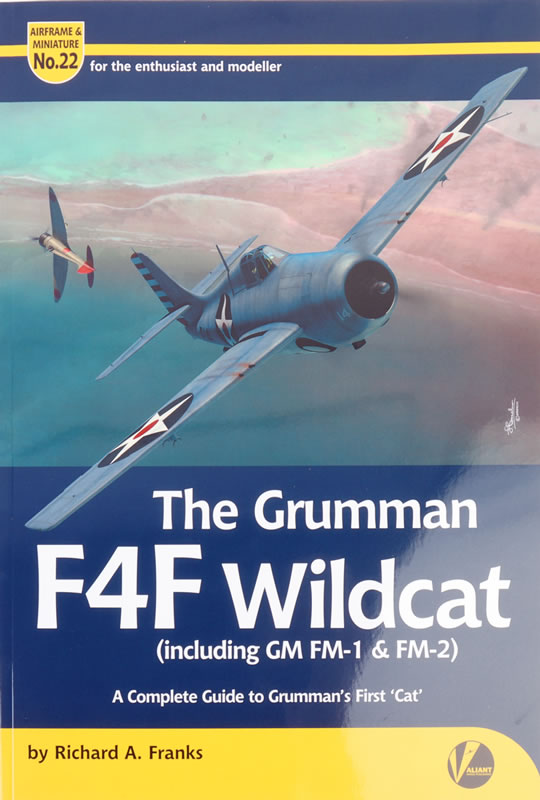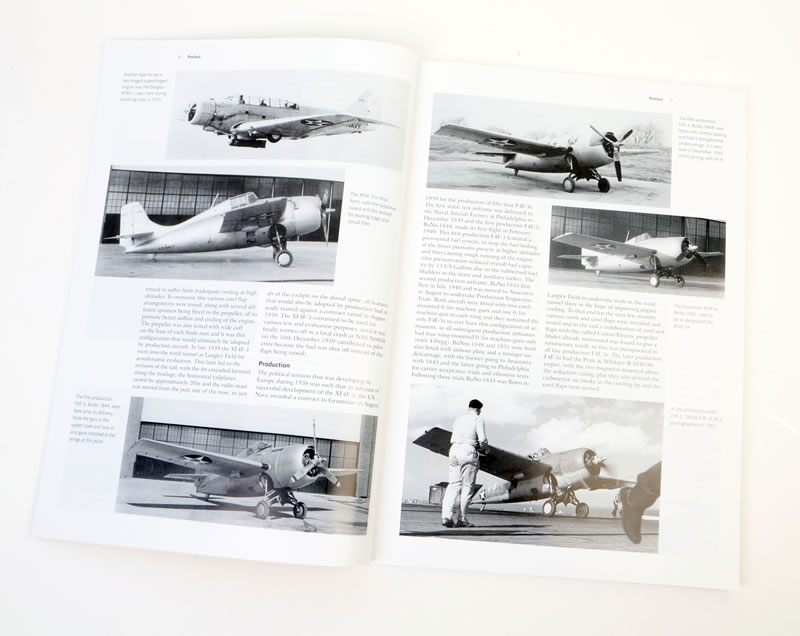Grumman F4F Wildcat
including GM FM-1 & FM2
A complete Guide to Grumman’s first ‘Cat’
by Richard A. Franks

Valiant Wings Publishing
Airframe Album No. 22
S u m m a r y |
| Publisher and Title: |
Grumman F4F Wildcat including GM FM-1 & FM2
A complete Guide to Grumman’s first ‘Cat’
Airframe Album No. 22
by
Richard A . Franks
Valiant Wings Publishing |
| ISBN: |
978-1-912932-35-1 |
| Media: |
208 pages in A4 portrait mode, many photographs and walkarounds, colour profiles, historical manual drawings, line drawings and model details. |
| Price: |
GBP£26.95 plus shipping available online from Valiant Wings
GBP£26.95 plus shipping available online from Hannants
and stockists worldwide. |
| Review Type: |
First Read |
| Advantages: |
Beautifully produced on quality paper, well bound so that it can be opened flat, masses of great information - photos, drawings and colour schemes - and good lists of all things a modeller needs to produce the next masterpiece. |
| Disadvantages: |
None noted. |
| Conclusion: |
This really is an exceptionally useful volume that should be in every Fairey Barracuda or Fleet Air Arm modeller’s library, regardless of which scale one works in, and I recommend it wholeheartedly. |
Reviewed by Graham Carter

This is the latest in this popular series of modelling and technical books. This is a large edition, with 208 A4 pages, well bound with a glossy card cover and printed on quality glossy paper that allows excellent reproduction of images and drawings. The cover is adorned with a Jerry Boucher commissioned illustration of a VF-6 Wildcat attacking a Type 96 “Claude” in February 1942 . There is much to appeal to the historian and technically-minded person as well as the modeller, with many pages devoted to builds by Libor Jekl and Steve A Evans in the popular scales as well as a listing of available kits and accessories.

Following the familiar path, the volume begins with a Preface and introduction of some twenty-two pages covering the story of the development of the Wildcats/ Martlets and their usage by a number of forces as well as the USA. B&W photos illustrate most of these.

Chapter 1 is four pages of the Evolution of the prototypes, followed by fourteen pages on the production models and then a further five pages devoted to projects such as floatplanes , civil and trials aircraft. These changes are illustrated with port-side sketches by Juraj Jankovic.

Next comes Chapter 4 of 38 pages of info on Camouflage and Markings which provides information and photos or colour drawings by Richard Caruana of the schemes worn by examples from most users. These start with those colourful pre/early war ‘yellow-wing’ schemes and pass through the early greys, then on to the blues and the temperate Sea Schemes of the FAA and covering the schemes applied to other users. Here there is a reference and drawing of the Martlet MkIII AX736 ‘X’ of 805 NAS in North Africa with Middle Stone/Dark Earth upper colours. I have always understood that collective wisdom was that these ’desert’ Martlets were plain Middle Stone over Azure Blue and wonder where this ‘new’ info has come from. Of course I stand to be corrected on this point, it’s just that I have seen a lot of references and models built in the plain upper colour.
At the end of this chapter is a 1/48 drawing sheet showing the location of stencils on the airframe.
Chapter 5 varies from early editions in that it is devoted to a round-up of available kits in the major scales, and along with a handy table of airframe dimensions for each of the main variants of the F4F/ FM-1 and -2 and their sizes in each of the main scales. Each of the main available kits is described and an outline of any strengths or weaknesses is given. This will assist modellers to select the kit that best suits their skills and pockets.
There then follows Chapter 6, which covers builds by Libor Jekl of the newish Airfix 1/72 F4F-4 kit which he craftily builds as an interchangeable straight and folded wing. Next, Libor builds and detail the Arma Hobby F4F-4 kit. Steve A Evans then builds the Eduard 1/48 ‘Profipack’ F4-F3 kit and the Trumpeter 1/32 F4F-4 in FAA colours. All of these builds are well-illustrated and written and do point out a couple of ways to improve or tackle each kit.
Chapter 7 is ‘Building a Selection’ in which each variant from the original biplane model G-16 through dozens of variants to the civil crop-sprayers, is illustrated with an annotated sketch to point out the differences or special features of each, by Juraj Jankovic. And again I would request that some of these should be underside drawings to illustrate important features that do not show up in the upper three-quarter views provided.
Then Chapter 8 covers the In Detail with 47 pages containing sections on the engine, cockpit interiors, wings and control surfaces, undercarriage, armament, ordnance, electrical and radar, ground equipment and miscellaneous bits and bobs. All of these are covered in some depth with clear detailed contemporary B&W photos and some colour images of preserved aircraft. All photos have good captions and should be a boon for the super-detailer among modellers.
There are then four appendices covering, in alphabetic lists by scale, all of the kits that have been available, accessories, decals and a bibliography. At fourteen close spaces triple-columned pages a hell of a lot of work has gone into compiling these lists and I commend the researchers for this task.
Inside the rear cover are the familiar scale drawings. In this case there are eight fold-out sheets showing the different variants in profile and then plan views of upper and lower surfaces, all in 1/48.
This really is a very useful volume that should be in every carrier-borne aircraft modeller’s library, regardless of which scale one works in, and I recommend it wholehearttedly.
It brings together a great deal of information in a single volume and therein lies its usefulness.
Thanks to Valiant Wings Publishing for the sample.
Review Copyright © 2023 by Graham Carter
This Page Created on 20 December, 2023
Last updated
21 December, 2023
Back to HyperScale Main Page
Back to Reviews Page
|
